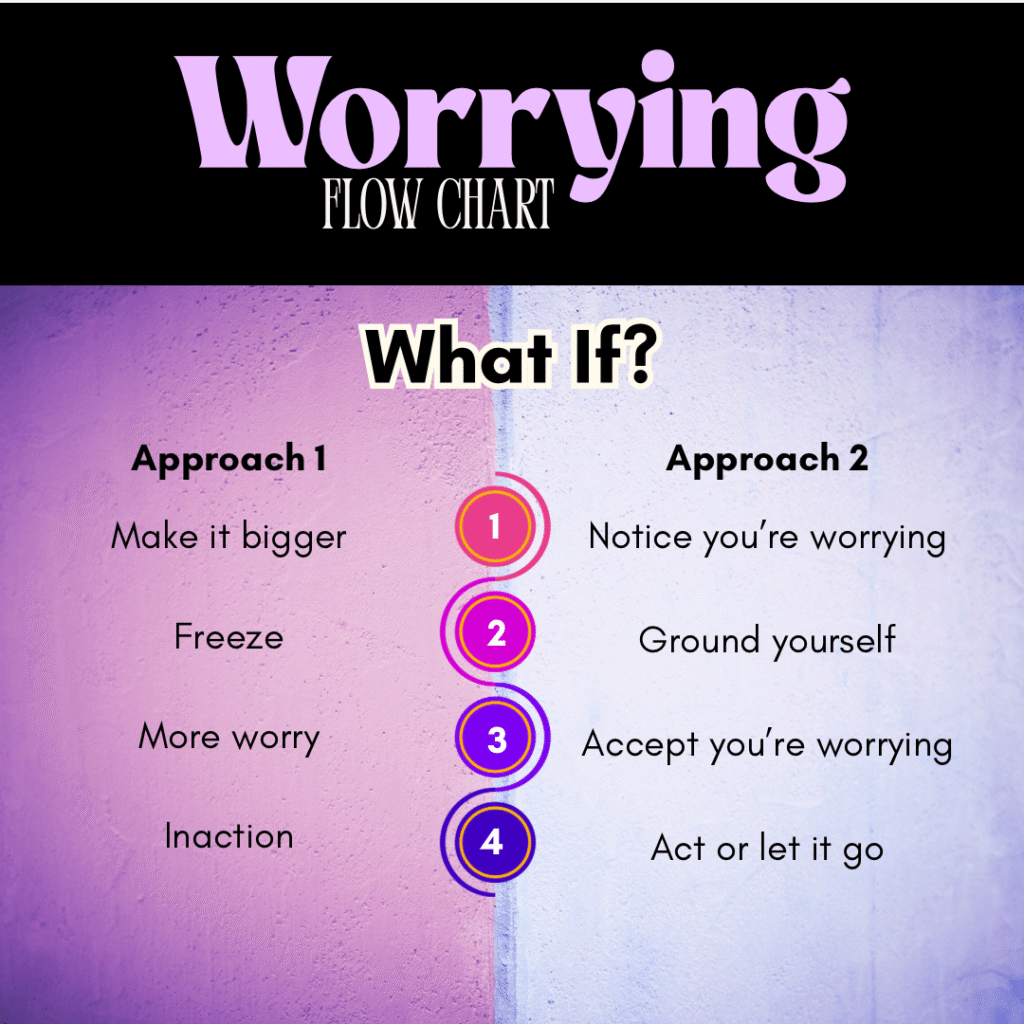Many of us believe that by worrying, we’re preparing for trouble ahead. In reality, worry often makes us feel more anxious, more overwhelmed, and less safe. Worry is your brain’s way of anticipating danger, a kind of mental “preparation.” And to be fair, a little worry can be helpful. It can keep us alert, help us plan ahead, and push us toward healthier decisions¹.
But when worry spirals out of control? It stops helping and starts hurting. Worrying and mental health are very linked to each other.
Most people worry when they’re alone. Younger generations struggle more then older ones. The topics people worry most about? Money, family and other loved ones.
About 30 percent struggled with worrying when trying to fall asleep. No surprise people who worry a lot, have a higher chance of having sleep problems.
Worry: A Negative Daydream?
If you’ve ever found yourself in a mental loop of “what if” thoughts, you’re not alone. The average American worries for 2 hours and 18 minutes a day! Worry often feels productive. Like you’re getting ahead of something. But it’s usually a form of negative daydreaming. When you worry, your mind escapes the present and drifts into imagined futures (usually worst-case scenarios).
It’s like storytelling, but the scary kind.
Most of us don’t sit around worrying about what will go right. Worry almost always focuses on what might go wrong. And if that becomes a habit, it starts to shape how safe you feel in the world. Even when nothing is actually wrong.
When Worry Becomes a Problem
Some worry is normal. But chronic or excessive worry can:
- Disrupt your sleep
- Cause headaches or stomach pain
- Lower your appetite
- Affect your mental health
- Reduce your focus and memory
- Keep you in a state of tension all day²
If this sounds familiar, it might be more than just a habit. Excessive worry can be a sign of:
- Generalized Anxiety Disorder (GAD)
- Depression
- Perfectionism or control-related stress³
You might find yourself constantly anticipating problems, playing out scenarios, or mentally rehearsing conversations, even when it drains you. You’re doing it because your brain thinks it’s helping.
The False Alarm: What Research Shows
Here’s the truth: most of what we worry about never happens.
Researchers at Penn State University asked people with GAD to write down their worries for 30 days⁴. The participants reviewed their list each night to track which worries had come true.
The results?
- 91% of their worries never happened
- Of the 9% that did happen, many went better than expected
- About 25% of participants saw none of their worries come true
Let that sink in. Your brain is sounding the alarm, but often unnecessarily.
Grounding Yourself in the Present
Worry pulls us into the past or future. The antidote? The present moment.
Try this:
- Walk barefoot through the grass. Notice the texture. Be in the moment.
- Do a color walk: choose a color (like yellow) and spot it during your walk. You’ll be surprised by all the new things you notice.
- Use your senses: What can you see? Hear? Smell? Touch? Taste? Your senses help you ground in the present moment.
This brings you back into your body, not your fears. It may sound small, but sensory grounding helps calm the nervous system⁵.
Simple Strategies to Manage Worry
Schedule Worry Time
Instead of worrying all day, set aside 15 minutes to write down your worries at the same time every evening. This “worry window” helps contain your anxious thoughts and gives your brain permission to pause outside that time⁶. It’s a CBT-based tool used in therapy, and it actually works.
When you catch yourself worrying mid-day, say:
“Not now. I’ll save this for my 9:00 pm worry time.”
It might seem hard at first. But give it a couple of weeks of practice. See if you can notice the worrying becoming less during the day. If 15 minutes is to long or to short adapt however you like. Just don’t let worrying take over your entire day.
Practice Mindfulness
Worry thrives on autopilot. Mindfulness gently brings you back. Even one slow breath can help.
Try:
- 4-7-8 breathing. In for 4, hold for 7, out for 8 seconds. You could also try box breathing. For example: in for 4, hold for 4 and out for 4 seconds. If you feel this exercise is to hard or you feel uncomfortable, skip this one and use one of the following exercises.
- A five-minute body scan. You can do this by yourself or find a guided one on YouTube
- Focusing on one sound or texture near you
Acceptance (not Avoidance)
ACT therapy (Acceptance and Commitment Therapy), might be beneficial. In short: accept the thought/ worry don’t push it away. Label it as it is: I’m having a thought about… this creates distance between you and the thought. ACT therapy is much more then just this. If this sounds helpful, it might be worth looking into.
You learn to accept the presence of worry without letting it run your life.

Journal & Reflect
Write your worries down, so they’re out of your head and on to the paper. Then ask:
- Can I do something about this?
- Is this actually happening, or just a possibility?
- What would be the best case scenario here?
Move Your Body
Physical movement literally shifts your brain state. A 30-minute walk can reduce anxiety and increase calm, especially when combined with mindfulness⁷. (Hello, color walk!) It gets you in to the present moment. Like mentioned before, a great medicine to worrying!
Talk About It
Don’t carry your worries alone. Share with someone safe: a friend, a therapist, or even voice note yourself. Sometimes speaking your thoughts makes them less heavy. Sharing them with someone might give you new insights as well.
You’re Not Alone in This
Your brain wants to protect you. That’s why it worries. But you don’t have to let that worry take the wheel.With the right tools, support, and self-awareness, you can learn to manage it and even soften it.
Not everything needs fixing. But everything deserves kindness.
Disclaimer: I’m not a mental health professional, everything here is shared from research and personal experience. If you’re feeling overwhelmed or need support, please consider talking to a qualified professional. You’re not alone. If you’re in the U.S., you can call or text 988 anytime. For help in other countries, visit https://findahelpline.com.
Sources
- Sweeny, K. (2020). The Surprising Upside of Worry. Scientific American.
- National Institute of Mental Health (NIMH). Generalized Anxiety Disorder. https://www.nimh.nih.gov
- Harvard Health Publishing. Worry and anxiety: Is there a difference?
- LaFreniere, L. & Newman, M. (2016). Penn State Worry Outcomes Study. Published in Behavior Therapy.
- Anxiety Canada. Grounding Techniques for Anxiety
- NHS UK. Tips for managing worry and overthinking
- Harvard Medical School. Exercise and anxiety: A natural cure?
8. Study conducted by Talker Research on behalf of Avocado Green Mattress, the survey also looked more generally at “worry” and the impact this has on Americans’ lives.

